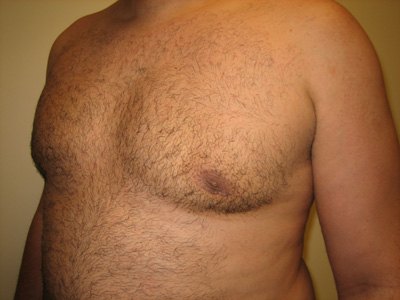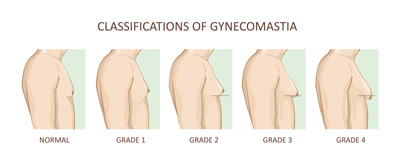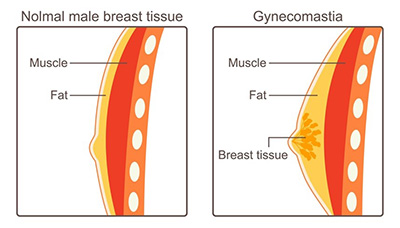
Call (516) 365-3511 to Schedule an Appointment
Gynecomastia is a medical condition that causes male breasts to overdevelop, leading to enlarged breasts, puffy nipples, and other painful, embarrassing symptoms. Enlarged male breasts often happen to pre-teens, teenagers, and older men, but men of all ages may develop gynecomastia. The excess glandular tissue may require surgical removal to create a flatter, more masculine chest contour. Dr. Arnold Breitbart is a board-certified plastic surgeon specializing in gynecomastia correction with male breast reduction. Many of his patients have struggled with "man boobs" since adolescence.



Gynecomastia causes extreme embarrassment in most cases and patients avoid social situations such as being seen on the beach or in the locker room. Adolescents and adults with gynecomastia suffer the emotional consequences of being teased by others, and can unfortunately experience a profound lack of self-esteem. By restoring a natural-looking, masculine and contoured chest, male breast reduction surgery can dramatically increase the patient’s self confidence.

Dr. Arnold Breitbart tailors the male breast reduction procedure to treat specific problems of each individual. Liposuction is usually used in conjunction with gynecomastia surgery to finely sculpt the breast and eliminate any excess fat. For some patients, Liposuction alone can reduce the breast fullness. In other patients, excess breast tissue or skin may need to be directly excised. The goal in all patients is to create a flatter masculine chest, while minimizing scars. In virtually all patients, scars can be placed at the edge of the areola. These scars are typically hardly visible, or not visible at all.

Patients can usually return to school or work within a few days after surgery. Most patients have very little pain. A compression garment is worn for a few weeks after surgery in order to reduce swelling and expedite the final appearance. Male breast reduction surgery causes an immediate dramatic improvement of the chest shape, and the contour continues to improve over the following weeks as all swelling resolves.

Following gynecomastia surgery, patients typically experience a dramatic improvement in self-esteem and a newly found confidence among their peers. It is common for patients to become more social and less introverted following gynecomastia surgery, as their self-confidence significantly improves and they no longer are afraid of revealing their chest in public.
Gynecomastia may have one or more causes and is linked to some medications and drug use, such as marijuana, anabolic steroids, and heroin. Although many cases of gynecomastia cannot be specifically linked to a particular medical condition, some reasons gynecomastia develops include:
Enlarged male breasts are most often benign (non-cancerous), and breast cancer in men is exceedingly rare. Gynecomastia in newborn babies is typically caused by residual estrogen in the infant's blood from childbirth and resolves shortly after birth.
 Gynecomastia is the overgrowth of glandular (breast) tissue, but many men may have associated pseudogynecomastia, which is excess fatty tissue in the breasts that can be resolved with liposuction alone. Researchers have broken the condition into three sub-types: intermediate, florid, and fibrous gynecomastia. Your gynecomastia type is related to how long you've had excess breast tissue. Florid gynecomastia is the earliest stage when boys or men have experienced symptoms for four months or less and have increased tissue in the ducts. Gynecomastia enters the fibrous stage a year or more after symptoms arise and involves more stromal fibrosis (benign lumps). Intermediate gynecomastia is when the condition lasts longer than one year, which is when doctors recommend treatment.
Gynecomastia is the overgrowth of glandular (breast) tissue, but many men may have associated pseudogynecomastia, which is excess fatty tissue in the breasts that can be resolved with liposuction alone. Researchers have broken the condition into three sub-types: intermediate, florid, and fibrous gynecomastia. Your gynecomastia type is related to how long you've had excess breast tissue. Florid gynecomastia is the earliest stage when boys or men have experienced symptoms for four months or less and have increased tissue in the ducts. Gynecomastia enters the fibrous stage a year or more after symptoms arise and involves more stromal fibrosis (benign lumps). Intermediate gynecomastia is when the condition lasts longer than one year, which is when doctors recommend treatment.
Gynecomastia has grades of severity that progress from minimal excess breast tissue with puffy nipples to severe overdevelopment of the breasts that causes the tissue to crease the skin and droop or sag below that crease. The severity of your breast growth will affect your treatment plan or surgical technique.
Gynecomastia diagnosis starts with a consultation with your healthcare provider or our plastic surgeon. They will take your medical history; discuss your medications, previous medications, and drug use; and perform a physical exam. In most cases, further diagnostic testing is not necessary, but occasionally, there are indications for further studies or an endocrinology work-up.
Sometimes, gynecomastia symptoms are caused by fatty breast tissue in obese patients (pseudogynecomastia), breast cancer (rare), or an infection of the breast tissue (also rare). A breast evaluation with Dr. Breitbart can diagnose gynecomastia, determine the cause of your symptoms, and decide if surgical intervention is necessary.
 Gynecomastia surgery removes the excess breast tissue. For men and some teens who have struggled with "man boobs" for a year or longer, tissue removal may be necessary to improve their quality of life. During a consultation at our Long Island or NYC office, Dr. Breitbart can determine if gynecomastia surgery is right for you. Gynecomastia surgery typically requires patients to meet these criteria:
Gynecomastia surgery removes the excess breast tissue. For men and some teens who have struggled with "man boobs" for a year or longer, tissue removal may be necessary to improve their quality of life. During a consultation at our Long Island or NYC office, Dr. Breitbart can determine if gynecomastia surgery is right for you. Gynecomastia surgery typically requires patients to meet these criteria:
Adolescents may benefit from gynecomastia surgery, depending on their age and how long they have had gynecomastia.
Gynecomastia treatment in young males may start with "watchful waiting," meaning our plastic surgeon may recommend waiting to see if the condition resolves itself. Enlarged male breasts during puberty may improve without treatment, usually in six months to three years. However, these adolescents may experience significant mental health concerns during that time, which is another consideration for gynecomastia surgery. Another treatment option may involve adjusting medications and lifestyle habits to stop breast growth and resolve symptoms. Hormone therapy with an endocrinologist is occasionally indicated to improve gynecomastia.
There are two techniques for gynecomastia correction: liposuction and excision. Gynecomastia surgery with Dr. Breitbart is tailored to your specific anatomy, cosmetic goals, and other concerns. Liposuction is usually used and may be combined with a gland excisional procedure to finely sculpt the chest. For some patients, liposuction alone can reduce breast fullness if they have primarily excess fat with good skin elasticity, while others often also require breast gland tissue removal and possibly skin excision.
The goal of gynecomastia surgery for all patients is to create a flatter, masculine chest while minimizing scars. Most patients will have incision lines concealed at the edge of the areola (darker skin around the nipple), which heal nicely and are hardly visible.
Gynecomastia may occur in one or both breasts, starting as a lump or fatty tissue located under the nipple accompanied by soreness. The growth expands and may increase unevenly, causing nipple tenderness or pain upon touch. Pre-teens with gynecomastia typically have a breast bud about the size of a nickel or quarter under one or both breasts. Gynecomastia symptoms may be confused with other medical problems, which is why diagnosis with a qualified physician or plastic surgeon and possibly testing is necessary.
Many men with ongoing gynecomastia struggle with nipple sensitivity, chafing under t-shirts, and embarrassment over their "man boobs." Gynecomastia surgery can restore their body confidence.
The psychological impact of gynecomastia on young boys and men can be substantial. "Man boobs" may cause low self-esteem, a feeling of incompleteness, social phobias, and body dissatisfaction. Men with gynecomastia often experience body shame at social gatherings, and extreme cases may lead to suicidal thoughts.
A 2018 systematic review examined patients' quality of life and mental health before and after gynecomastia surgery, including physical pain, limitations, emotional discomfort, and vitality. These various studies found a statistically significant improvement in many areas, such as:
Many men reported better relationships with women, fewer limitations in daily activities, and less ridicule from others. They no longer felt embarrassed or isolated and experienced an improved personal life. Patients with depression and anxiety linked to gynecomastia saw improved psychological burden, suggesting a strong link between gynecomastia and psychological well-being. Treating the physical aspects of gynecomastia may drastically improve the mental health aspect of the condition.
Researchers suggest gynecomastia surgery with psychological evaluation may lead to the most successful management of symptoms.
 The healing process and timeline for male breast reduction to treat gynecomastia vary from patient to patient. Each procedure is customized to suit your individual needs, and the recovery depends on your natural healing properties, pain tolerance and the extent of the breast surgery.
The healing process and timeline for male breast reduction to treat gynecomastia vary from patient to patient. Each procedure is customized to suit your individual needs, and the recovery depends on your natural healing properties, pain tolerance and the extent of the breast surgery.
In most cases of gynecomastia, there is an excess of both fatty tissue and breast glandular tissue. These cases typically involve liposuction of the fatty component and direct excision of the glandular component. Incisions are usually made at the lower edge of the areola. They generally heal with a scar that is barely visible or not visible at all. When there is skin excess or substantial drooping of the breasts, skin excision may also be required. In cases where there is only fatty tissue excess, liposuction alone may adequately treat the condition. The type of procedure will directly impact your recovery.
Initial recovery from male breast reduction takes less than a week, and most patients can return to work or school after a few days. During this time, you need to avoid strenuous activity to promote healing and prevent complications. You will have a compression garment to help ease swelling. You need to wear the support garment for a few weeks for the best results.
A drain (thin, hollow tube) may be placed to drain fluid that may accumulate under the skin. Drains are typically removed the day after surgery. Incisions are closed with dissolvable stitches under the skin, so no stitch removal is required. Itchiness is common following surgery but be sure not to scratch the area.
You may use over-the-counter or prescription pain medications to ease the discomfort during recovery, which will depend on your pain tolerance and the type of procedure. Most patients do not require prescription pain medication.
Our board-certified plastic surgeon has these tips to help you through the recovery process after male breast reduction:
The cost of gynecomastia surgery or male breast reduction is unique for each patient. The severity of the condition and complexity of the procedure will affect the price, and the total cost includes fees for the plastic surgeon, anesthesia, and surgical facility and expenses for medical testing, post-surgery compression garments, and prescription medications.
You will receive a detailed price estimate during your gynecomastia consultation. However, be wary of a low-price tag from some surgeons as the cost may not include pre- and post-op care or the doctor may not have the experience or credentials to perform gynecomastia correction safely. Your results and health depend on a good surgeon, which is why it's best to choose a board-certified plastic surgeon.
Selecting the plastic surgeon to perform your gynecomastia surgery is one of the most important decisions. While there are many male breast reduction providers, it's in your best interest to choose a board-certified plastic surgeon specializing in aesthetic surgery to correct gynecomastia. These tips will help you narrow down your options:
Research the plastic surgeon's background because different surgeons have different skill levels and training. The highest quality results come from experienced surgeons certified by the American Board of Plastic Surgery (ABPS) because they have met the additional qualifications required by the organization, including completing annual continuing medical education (CME) courses on patient safety and new surgical techniques. Don't be confused by other official-sounding boards. The American Board of Medical Specialties does not certify any organizations with "cosmetic surgery" in the name; only ABPS is regulated under this medical body. Dr. Breitbart is ABPS-certified.
 View the patient gallery to see images of other gynecomastia patients. These photos help you understand the plastic surgeon's quality of work and can help you decide if they are the right surgeon for your needs and cosmetic goals for a masculine chest. See Dr. Breitbart's previous patients' gynecomastia results.
View the patient gallery to see images of other gynecomastia patients. These photos help you understand the plastic surgeon's quality of work and can help you decide if they are the right surgeon for your needs and cosmetic goals for a masculine chest. See Dr. Breitbart's previous patients' gynecomastia results.
Reviews of plastic surgeons' work can give you invaluable insight into their services, bedside manner, and how they address complications. Read reviews of Dr. Breitbart.
You won't know how you feel about a prospective plastic surgeon until you book an appointment. The initial consultation lets you ask questions about male breast reduction, determines if gynecomastia surgery is right for you, and helps you decide if you feel comfortable with the plastic surgeon, their medical team, and the office staff. Dr. Breitbart and his staff work to provide a welcoming atmosphere where patients feel comfortable.
Your plastic surgeon should not pressure you into treatment and should thoroughly answer your questions about gynecomastia surgery. You should feel confident in trusting your surgeon with your health, appearance, and aesthetic goals.
 Men typically see an immediate, dramatic improvement in their chest shape, which continues to look even better as the swelling subsides. The goal of male breast reduction is to provide a masculine contour with minimal scars. Dr. Breitbart usually places the incisions at the edge of the areola, so they are hardly noticeable, or not noticeable at all after recovery. Most of the swelling is gone within a few weeks after the surgery.
Men typically see an immediate, dramatic improvement in their chest shape, which continues to look even better as the swelling subsides. The goal of male breast reduction is to provide a masculine contour with minimal scars. Dr. Breitbart usually places the incisions at the edge of the areola, so they are hardly noticeable, or not noticeable at all after recovery. Most of the swelling is gone within a few weeks after the surgery.

Gynecomastia is an enlargement of the male breast. It is quite common, and for most patients, develops during adolescence and can persist. Although rarely associated with hormone problems or certain medications, it usually has no specific cause and can be treated effectively with surgery.
Liposuction is usually used to remove the fatty component of the enlarged breast tissue. In some patients, Liposuction alone can effectively treat the gynecomastia. In other patients, a small incision is made at the edge of the areola to remove any firm breast tissue that cannot be effectively treated with Liposuction alone.
The scars are placed at the edge of the areola. These scars generally heal well and are either invisible or barely visible.
A compression garment is worn for 3-4 weeks after surgery. This helps to reduce swelling and expedite healing.
Following the post-op instructions provided by Dr. Breitbart and attending your follow-up visits are vital for the recovery process and your results. The general timeline for healing includes:
Puffy nipples can be a symptom of gynecomastia because the breast tissue underneath the nipples pushes the nipple-areolar complex outward. Gynecomastia correction removes the excess glandular tissue from your chest, which typically causes nipple puffiness to decrease significantly. Many male patients find their nipples shrink down and appear natural after gynecomastia surgery. If the primary male breast reduction doesn’t satisfactorily improve enlarged areolas, an additional minor procedure may be necessary to address nipple concerns.
Gynecomastia surgery has a very high satisfaction rate among Dr. Breitbart’s patients with extremely successful results. In Dr. Breitbart’s experience, the need for revision surgery is quite rare, as is the chance of gynecomastia recurrence after surgery. For patients with substantial excess skin, minor touch-up surgery may occasionally be necessary if the patient has residual excess skin after healing. Obviously, it is in the patient’s best interest after surgery to avoid things which can contribute to gynecomastia, such as steroid supplements and marijuana use.
Gynecomastia is a medical condition affecting many ages and body types. Muscular, average, and overweight physiques can all qualify for male breast reduction. It’s not so much your body type that affects your procedure but the severity of gynecomastia, which is broken into grades:
Patients with all body types can struggle with gynecomastia. You may qualify for male breast reduction if you have a high BMI, an athletic body, or an average physique.
There is no age limit for male breast reduction. Dr. Breitbart has treated patients ranging from teenagers to those in their 70s. However, younger patients around puberty may have to wait to ensure the condition is persisting, as gynecomastia may be temporary during adolescence. Dr. Breitbart determines candidacy on a case-by-case basis, and severe cases of gynecomastia in younger patients may warrant male breast reduction sooner.
Gynecomastia is linked to testosterone, which decreases with age. Men may develop enlarged male breasts as they get older. Old age is not a factor for candidacy. If you are in good overall health and understand the benefits and risks of the procedure, gynecomastia surgery may be an option for you.
Hormonal imbalances may trigger gynecomastia in men, particularly a decrease in testosterone or an increase in estrogen. The condition often affects male infants due to the mother’s estrogen but goes away after a few weeks. Some boys experience gynecomastia during puberty when hormones fluctuate rapidly. Adult men may develop gynecomastia because of other health concerns such as hypogonadism, tumors, hyperthyroidism, kidney failure, aging, malnutrition, liver failure, and cirrhosis.
Medications can cause gynecomastia, such as anabolic steroids, AIDS medications, ADHD drugs, anti-anxiety medications, tricyclic antidepressants, antibiotics, chemotherapy, heart medications, and drugs used to treat ulcers. Illicit or recreational drug use and excessive alcohol consumption can also lead to gynecomastia.
Men who are most at risk for gynecomastia include adolescents, older men with certain health conditions, and those who use anabolic steroids for increased athletic abilities.
Gynecomastia is a common concern among men, but male breast cancer is a rare occurrence. The risk of the enlarged male breast tissue turning cancerous is very small. However, men with breast cancer in their family history or a gene mutation linked to breast cancer have a higher risk. Men are encouraged to do self-examinations to feel for lumps or changes to their breast tissue and schedule an appointment with their healthcare provider if they notice changes or concerns during the self-check.
You will usually be under general anesthesia during male breast reduction and won't feel any pain during the procedure. You can expect some discomfort during recovery with swelling, numbness, or tingling in the chest, and possibly some bruising. Most patients manage pain with over-the-counter medications. Dr. Breitbart's patients often report the discomfort is mild and tolerable. Take your pain medicines as directed at the right time intervals to reduce discomfort; and follow all post-op instructions.
Male breast reduction permanently removes the excess breast tissue, which will not grow back. However, there is some risk of regrowth if the patient continues medication, drug use, or unhealthy lifestyle related to gynecomastia development. Patients who use marijuana after surgery may experience some recurrence and untreated adrenal or pituitary tumors or hormonal imbalances may cause gynecomastia to return. Pseudogynecomastia treated with liposuction may reoccur with weight gain because the remaining fat cells can expand.
Most health insurance plans do not cover male breast reduction. Dr. Breitbart offers financing options to help patients cover the cost of gynecomastia surgery with set monthly payments — our offices partner with CareCredit, Alphaeon Credit, United Credit, and PatientFi Credit.